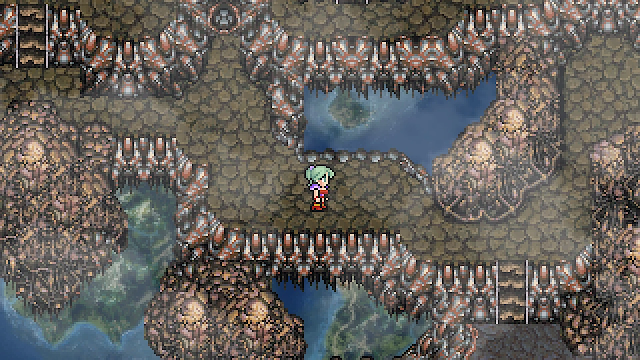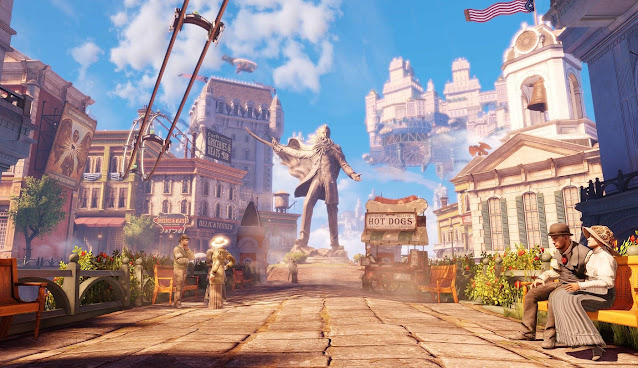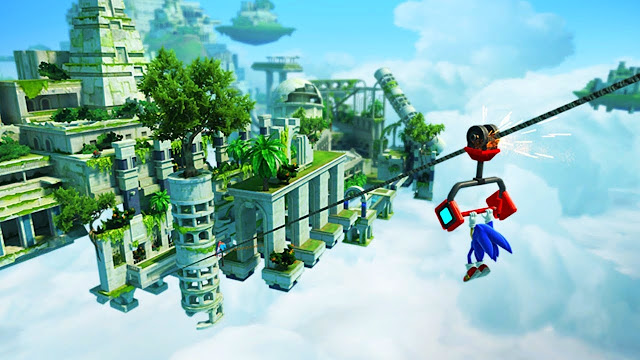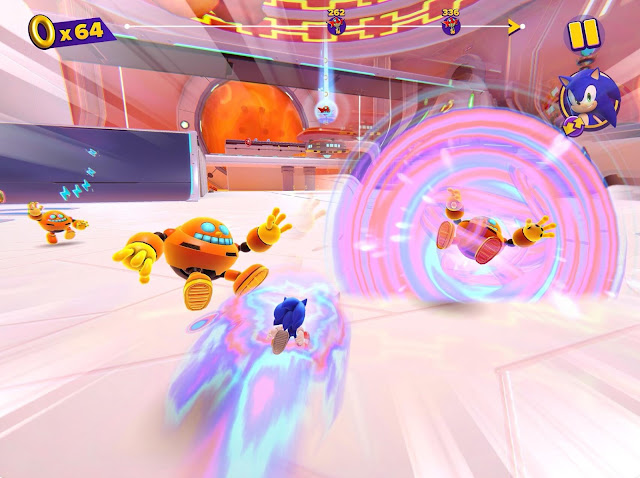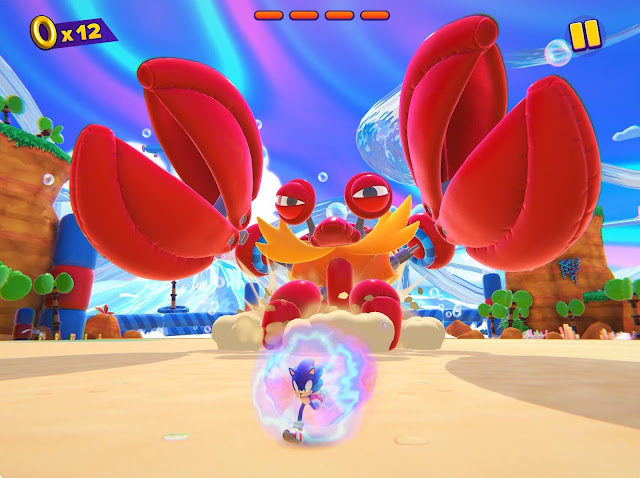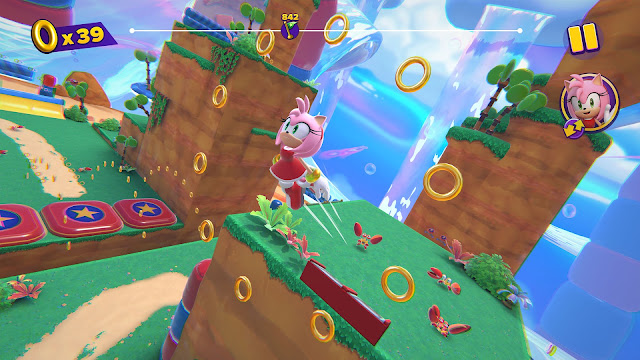How about a retro review for this unplanned throwback kind of Thursday? That's exactly what we're in for together with this retro review of Mario Golf: Toadstool Tour from the GameCube generation.
"Fore" score and several birdies ago, Mario and friends
stepped out on to the tee for a GameCube golf outing.
I can't get enough cartoony arcade-y golf games. Whether it's Hot Shots Golf/Everybody's Golf, PANGYA, or, of course, Mario Golf, nothing gets my love of video game golf going than colorful characters playing on fantastical courses. That's why I couldn't resist going back to the GameCube's Mario Golf title, Mario Golf: Toadstool Tour. I've pretty much squeezed out all of the goodness of the Switch's Super Rush, the 3DS's exquisite World Tour, and the Nintendo 64 original as well, so it only made sense to move on to the GameCube one, a bit of a game I left to my teenaged years and haven't played in modern times. Mario Golf: Toadstool Tour is pretty much more of the same from its Nintendo 64 predecessor, adding some new features and unfortunately some bumps in the green as well.
Mario Golf: Toadstool Tour features a colorful cast of over a dozen Mushroom Kingdom all-stars, each with their own stats, such as maximum drive (how far they can hit the ball) and arc/trajectory of their shots. There are of course your mainstays of the series: Mario, Luigi, Peach, Daisy, Yoshi, Bowser, Wario, and Waluigi--of course--but there are also some less traditional picks, such as Koopa Troopa, Birdo, and the first time inclusion to the Mario Golf series of characters such as Diddy Kong and Bowser Jr., the latter of which had just debuted a year or two prior in Super Mario Sunshine.
 |
| Yoshi is but one of the returning playable Mushroom Kingdom characters from the N64 Mario Golf. |
Apart from Bowser Jr. who is a secret character, there are three other unlockable golfers as well. These are unlocked through completing specific modes and challenges within Toadstool Tour: whether it's beating all of the side games, achieving a certain amount of Best Badges--obtained by getting a Birdie or better on a given hole--and so forth. In addition to the characters yet to unlock, the base roster can also be upgraded to Star Character level by challenging them to a Character Match, a round of versus golf where the lowest score of each hole wins that hole. The player with the most holes won by the end of the round is the overall victor. Star Characters hit further, hit harder, and are best suited for more seasoned players.
 |
| Wario is one mean but decidedly not-so-lean power hitter! |
Toadstool Tour contains a wide amount of modes to play through aside from the Character Match. Tournament is the main means of unlocking new courses. You compete against a field of computer opponents to get the best score by the end of the round. The required score to come in first place seldom, if ever, changes, so it's less about "beating the field" and more "beating a certain score". There's also Ring Shot, which pits players against multiple holes across all six courses. The goal here is to hit your shots through all of the rings, and then successfully sink your ball into the hole with par or better. Easier said than done in later stages, as on many occasions you'll be tasked with hitting your shot far out of the safety of fairways and usually into bunkers, rough, and other hazards you'd usually wish to avoid.
Additionally, Practice Games help hone your golf skills, such as chipping, putting, and approaching. They each come in novice, intermediate, and expert modes. Then, there's the Near-Pin Challenge, taking place on the lone Par 3 short course in the game, Congo Canopy. Here, you're tasked with driving the ball as close to the pin as possible without missing the green. Birdie Challenge is an even more challenging version of this, tasking players with getting consecutive birdies on every hole within this treetop course.
Where Mario Golf: Toadstool Tour really shines mode-wise is in its multiplayer repertoire. For one, up to four players can play together, whether on separate controllers or sharing controllers or a controller. The multiplayer suite of modes includes traditional Stroke, Match, and Skins play that are all no stranger to any golf game worth their downswing, but also two-on-two Doubles play, playing with a randomized and limited amount of clubs in Club Slots mode, the coin-collecting Coin Shoot mode, and myriad more.
 |
| Up to four alternating players can take to the links together in one of many multiplayer modes. |
Toadstool Tour's tournaments, modes, and matches are played across seven unique 18-hole courses, one of which--the aforementioned Congo Canopy set in DK's Jungle--is the sole Par 3 short course. The initial two courses are pretty much standard fare and could be mistaken for real courses in a traditional golf game for the most part. It's not until you get to the desert ruins and canyons of Shifting Sands, the third course in the game, where things become more exotic and interesting.
 |
| While courses like Cheep Cheep Falls are generally grounded golfing experiences... |
It's a big shift from the starting two courses, Lakitu Valley and Cheep Cheep Falls, where fairways are large, greens are gentle, hazards are rare, and the courses are more grounded, to the final two courses of the game: Peach's Castle Grounds and Bowser Badlands, where things go deep off in the realm of the fantastical with full Mario and Mushroom Kingdom theming. I'm talking warp pipes that whisk your ball away closer to (or sometimes even further away from) the hole, Mario enemies like Bob-Ombs, Chain Chomps, and Thwomps, and rivers full of lava in the case of the latter course of Bowser's. These final two courses will put even the most professional Toadstool Tourer through their paces. They are TOUGH.
 |
| ...You'll soon find that there's fungus among us (and plenty of other surprises) in later courses! |
Of course, all the characters, modes, and courses within a golf game would be all for nothing if the actual golfing gameplay wasn't up to... well, par. Fortunately and probably without much in the way of needing to worry about it, Mario Golf: Toadstool Tour scores under par here. (For those not too acquainted with golf terminology, that's a good thing.)
From typical golf game aspects like being able to survey and get an overview of the topography and play environment of each hole by moving the camera around--an effortless task--to having a full repertoire of helpful information like wind speed and direction, elevation to the hole, incline, etc., Mario Golf: Toadstool Tour does not leave much out to assist you with taking your best shots possible on the links.
The traditional three-click gauge from the OG Mario Golf on the Nintendo 64 is here and present, offering a bit of spin on this classic. Starting the gauge is still performed by pressing the A button, but on the second button press--the one to set the power of your shot--you can either opt to press A again or B this time around. If the former is selected, this turns the rest of the current shot into automatic mode, where the accuracy of the shot is determined by the game randomly. If B is pressed, manual mode is selected, allowing players to time the accuracy of their shot, as well as add any topspin or backspin to their shot through combinations of A and then B or vice versa, upon setting the accuracy. Spin in general is a new addition to the Mario Golf series introduced within Toadstool Tour.
 |
| Luigi may be beached currently, but he's ready to escape the sand with a well-hit chip shot. |
Returning from the past two Mario Golf games is that of being able to determine where you hit the ball, allowing you to arc your shots more carefully, best used when attempting to avoid obstacles like trees. Another aspect from past Mario Golf games: power shots, return as well, allowing harder drives, chips, and more to happen as long as your character has enough of them left to use. With each power shot used that is not given perfect sweet spot timing (i.e. the power bar on the left side and the right side both are not perfectly synced and aligned together), the power shot counter goes down one.
For all that Toadstool Tour does right in improving upon Mario Golf on the Nintendo 64, it does do some things that are a bit bewildering to the point of me shaking me head. For one, putting is much more challenging than it needs to be, by virtue of the power gauge moving so fast when starting it. This makes short putts harder to manage and sink than one might imagine. Further, the camera angles at times tend to linger on your character awkwardly longer than they otherwise should upon them hitting their shots. In the case of putting, it'd be nice to know where I went wrong with the angle of my putt, but that's too bad because the game opted to focus on my golfer instead for more than necessary. While these issues are more gripes and minor issues than anything else, they do add up overtime and make for a somewhat frustrating experience occasionally.
 |
| While medium to long putts aren't too taxing to time the power of, those short, less-than-3-ft. shots can be NASTY! |
Now that we've talked in detail about where Mario Golf: Toadstool Tour falters a little bit, let's chat about where the game goes above and beyond--its charm and personality. Everything from character animations, hole out celebrations, and taunts (remember taunts?) to the colorful and vibrant menus chockful of character, there's just so much personality and lovely vibes pulsating throughout this golfing package. I don't think I'm telling tales out of the clubhouse here when I say that Toadstool Tour really makes modern Mario sports games seem sterile by comparison. Meanwhile, Motoi Sakuraba delivers one of his best Mario sports soundtracks with cheerful, chipper music that really gets you in the mood to do some happy-go-lucky golfing with Mario and friends. The voice quips from the Mushroom Kingdom crew delight, and even has some more fully voiced stuff in the hilarious animated intro and surprisingly in the letters that your Character Match opponents send as a means of challenging you to a round.
 |
| Bunkers and beaches abound around the Blooper Bay course. |
All in all, if Mario Golf: Toadstool Tour was a course like the seven within its game, it wouldn't be without its unsightly divots and scuffmarks on its otherwise smooth fairways and greens. Camera issues and putting woes can make for an aggravating experience at times, but everything else lives up to the good Mario Golf name. The level of character in the game is unmatched in most Mario sports games past and present, the course design is challenging and enjoyable, and overall, the golf gameplay experience is engaging and worthwhile. Even long after unlocking all characters, courses, and modes, I continue to return to the links with Mario and the Mushroom Kingdom crew, as Toadstool Tour definitely endures the test of time, sinking most of its putts to head home with a gold trophy.
[SPC Says: B+]













